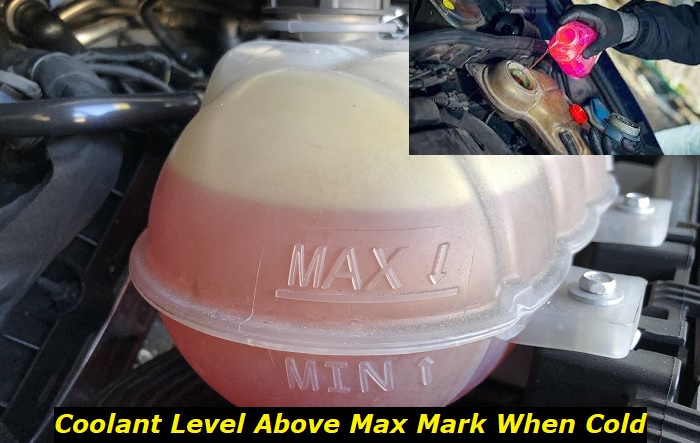Before you embark on a journey in your car, you should check the various car gauges to ensure the journey goes smoothly. You should check the engine oil level, the wiper water level, tire pressure, and, of course, the coolant level. More often than not, we skim the coolant reservoir to confirm the coolant level is at least 'MIN'.
Coolant level problems highlights
- Level of urgency:high
- Commonreasons:cooling system problems, leaks, coolant expands, circulation issues
- DIY diagnostics:quite complicated
- DIY repair:impossible
- Price of repair:$300 - $850
- Time for repair:3 - 9 hours
- If ignored:engine overheating and failure, cooling equipment problems

Should the coolant be above MAX when the engine is cold?
When you drive your car for a while, the engine gets hot, and the cooling system kicks in. A vehicle moving at around 50 miles an hour will average 4,000 combustions per minute. This, together with the friction of the moving engine parts, makes the engine very hot. This requires the cooling system to be effective; otherwise, the engine will fry in a matter of minutes.
The coolant flows through the cooling system, which starts at the reservoir, to the radiator, the water pump, the engine, and back to the radiator. The radiator is made of a mesh and narrow channels the coolant flows through. This increases the surface area the coolant comes into constant with, hence cooling it much faster. The radiator fan increases the cooling time, making the coolant ready to flow back into the engine to absorb the generated heat.
Because of the continuous flow of the coolant under hot conditions, its level in the coolant reservoir is bound to drop. This does not happen overnight or after a day's drive. The reservoir cap and the radiator cap ensure no coolant gets lost. It will take months for the coolant level to drop an inch.
In our case, we are looking into a situation where the coolant level actually rises or remains high when the engine is cold. Typically, the coolant level in your car should never be above MAX when the engine is cold. If this happens, then it means there could be a problem not only with the cooling system but also with the engine. Such an issue should be addressed as soon as possible; otherwise, you might end up replacing the entire cooling system or, worse still, the entire engine.
The coolant should normally be within the maximum and minimum levels, whether the engine is hot or cold. However, because a car's cooling system is sealed, there should be no leakage, and the fluid level should remain relatively constant.
How does the cooling system work?
The radiator is designed to be filled and without air, even when the engine is hot. If you were to open the radiator cap even when the engine is hot (not advisable), the radiator would be full. The reservoir cap, which is usually marked 15 psi, acts as a pressure release valve and increases the boiling point by 450F. The coolant in the radiator is pressurized and very hot, and it's for this reason, you should never open the radiator cap when the engine is hot.
When the engine grows hotter as you drive, the coolant becomes hotter too, and the radiator fan goes into overdrive to cool down the coolant. Upon the coolant in the radiator reaching the maximum safety levels, the release valve releases the excess coolant to the coolant reservoir. This makes the coolant level in the reservoir rise.
When you park your car, the engine is no longer active, and there won't be a need to cool. The coolant and other car fluids and components start cooling too. As is the case with any other liquid, the coolant expands when hot and contracts when it cools down.
When the radiator starts cooling down, the release pressure valve allows the coolant overflow that had gone to the reservoir to flow back. This causes the coolant level to drop in the reservoir.
What causes the coolant level to be above Max?
1) Overfilling the reservoir
The main reason the coolant may be above Max level is if you refill it yourself, unknowingly or unknowingly. The reservoir or expansion coolant container under the hood requires regular refilling. You or a gas station attendant might have refilled the reservoir without taking note of the Max level. This is not really a big problem because it doesn't point to a problem with the car. To correct this issue, siphon the coolant to any point below Max but above Min.
2) A faulty radiator cap
The simple-looking cap is critical in ensuring the cooling system stays pressurized and does not spill. The radiator cap has two rubber seals, one to help keep the cap in place and the other to adjust the pressure inside the radiator.
If the cap is faulty, the rubber can remain stuck in an open or closed position. If the rubber seals are stuck in a close position, pressure won't escape, and this exhibits a pressurized cooling system. This will then make the coolant in the reservoir remain high and possibly above the Max level.
The solution to this problem is to replace the radiator cap. It is a cheap cap that can be found in almost every aftermarket auto shop. However, given the important role this cap plays in cooling the engine and even preventing the engine from becoming totaled, it would be advisable to order a radiator cap from an authorized dealer of your car. The psi should be around 15 though you might find one with a 20 psi capacity. An original cap lasts longer, and you can rest easy knowing it won't abruptly fail.
3) Blocked cooling system
If replacing the radiator cap doesn't solve the coolant remaining above Max level, it is time to consider checking whether the system is blocked. Among the things that can cause the cooling system to be blocked include the following;
- The serpentine belt is blocked
- Radiator is blocked
- A faulty thermostat
- A bad water pump
- There is air in the system
A blocked cooling system means the coolant will not reach some parts of the system, which might result in the reservoir overfilling. Diagnosing the problem might take time and cost you money.
4) Using water instead of coolant
Many people out there simply add water when the reservoir runs low. It is worth noting that coolant is a mixture of water and glycol. However, coolant has a higher boiling point and contains some additives, which make it a better cooling fluid than water. Plain water, on the other hand, has a lower boiling point and bubbles when it boils.
The lower boiling point might make the reservoir level go above Max even when the car is idling. The other potential problem with using plain water is that it is more susceptible to collecting rust and sludge, which can block the cooling system. As discussed above, a high coolant level in the reservoir can be caused when the cooling system is blocked.
5) A blown head gasket
The head gasket is the most overworked in the whole car. It seals off the head cylinder and the block to allow oil and the coolant to flow from one to the other. When the head gasket is blown, the coolant will leave the waterways in the engine and start leaking into oil channels. The same will happen with the oil, leaking and even entering the combustion chambers.
A blown gasket will not manage to hold and channel the exhaust gases as required. Some exhaust gases will leak out, and some will find their way into the cooling system. This will cause the coolant level in the reservoir to rise and, in some cases, overflow even when the engine is cold.
To confirm whether the head gasket is the problem, fill up the radiator with coolant and start the engine. If the gasket is blown, combustion pressure will begin building in the cooling system, and this will cause the coolant to overflow.
The solution to a blown head gasket is the costliest. It will require disassembling the engine and replacing several engine components as well as the head gasket itself.
Conclusion
If you find the coolant above the Max line, don't ignore or postpone looking into it. In many instances, this is an indicator of a more significant problem. If allowed to continue, you might replace very expensive components, like in the case of a blown head gasket. Regularly check the coolant level because you might catch this problem before it grows into a mountain.
About the authors
The CarAraC research team is composed of seasoned auto mechanics and automotive industry professionals, including individuals with advanced degrees and certifications in their field. Our team members boast prestigious credentials, reflecting their extensive knowledge and skills. These qualifications include: IMI: Institute of the Motor Industry, ASE-Certified Master Automobile Technicians; Coventry University, Graduate of MA in Automotive Journalism; Politecnico di Torino, Italy, MS Automotive Engineering; Ss. Cyril and Methodius University in Skopje, Mechanical University in Skopje; TOC Automotive College; DHA Suffa University, Department of Mechanical Engineering






Add comment